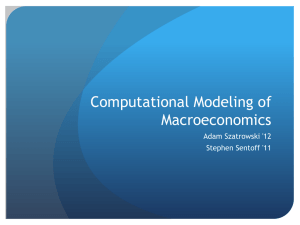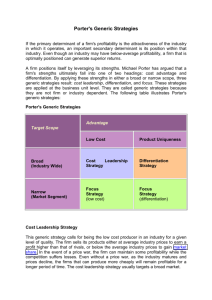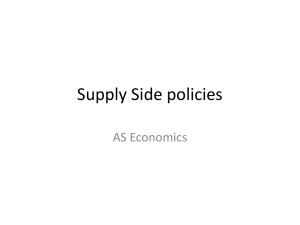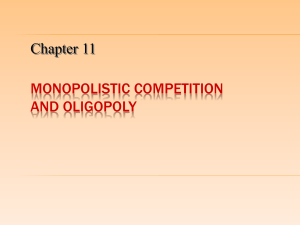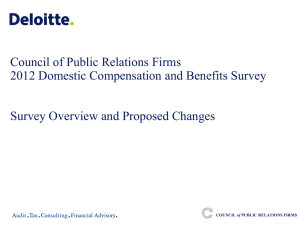Chapter 5 MAZ
advertisement
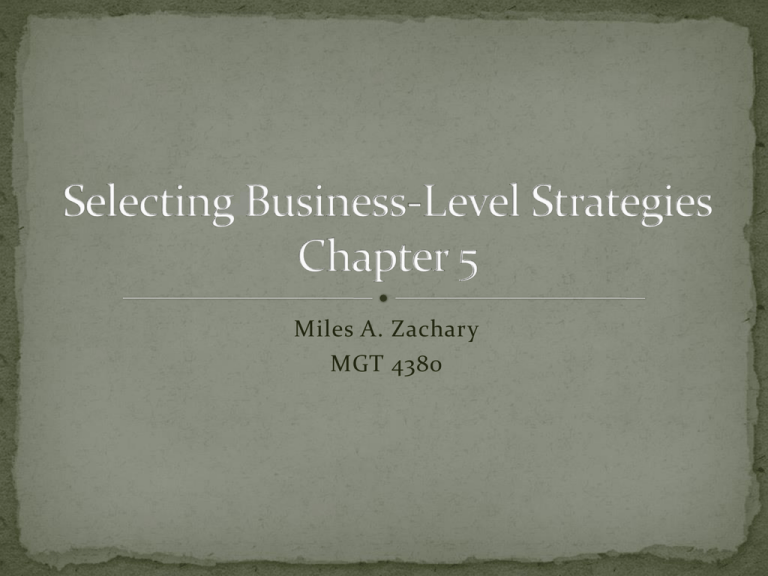
Miles A. Zachary MGT 4380 Business-level strategy address the question of how a firm will compete in a specific industry Developing business-level strategies requires not being mesmerized by all the nuanced strategies of firms in an industry How can executives cut through the mess? Generic Strategies-a general way of positioning a firm within an industry Best-known generic strategies developed by Michael Porter of Harvard Business School Two competitive dimensions Competitive advantage Involves whether a firm stresses lower costs or uniqueness Scope of Operation Determines whether a firm appeals to a general audience or a focused subset of consumers Four (4) traditional generic strategies Cost leadership Differentiation Focused (niche) cost leadership Focused (niche) differentiation In addition to the four (4) main generic strategies, two sub-strategies exist Best-Cost Strategy “Stuck-in-the-middle” Strategy Different generic strategies offer different value propositions to customers They also have different value chain configurations Cost leadership firms compete based on price and aim for a broad target market Sell goods for low prices Target general consumers Emphasize efficiency; spend little on advertising, market research, or R&D Often rely on economies of scale Cost of offering goods decreases as a firm is able to sell more items; expenses distributed across a greater number of items Ex.-Wal-Mart, Payless Shoe Source, etc. Advantages Low-cost providers better able to withstand price wars Discourages new entrants Advantage enhanced by high market share Disadvantages People perceive products and services as low-quality High volume necessary because low profit margins Need to focus on low cost blinds firms to subtle environmental trends Emphasis on efficiency makes it difficult to change quickly when needed Differentiators compete based on uniqueness and aim at a broad target market Attempt to convince customers to pay higher prices by providing unique and desirable features Emphasize that consumers “get what they pay for” Firms must communicate to consumers why they should pay higher prices—advertising! Ex.-Nike, FedEx, Ralph Lauren, etc. Advantages Strong margins = firms need less customers to make a profit Enduring differentiator firms create strong brand loyalty—less price sensitive Difficult for new entrants to compete with brand loyalty Disadvantages Customers may not be willing to pay higher prices Customers may prefer a cheaper alternative Competitors may be able to imitate features such that they are not sufficiently unique A focused cost leadership strategy entails competing based on price to target a narrow customer market Not necessarily the lowest price in the industry; it charges low prices relative to other firms that compete within the target market In other cases, the target market is defined by the sales channel used to reach customers Unique product distribution/retail A focused differentiation strategy requires offering unique features that fulfill the demands of a narrow market Similar to focused cost leadership strategy, focused differentiation sometimes focus on a particular sales channel Others target particular demographic groups Ex.-Whole Foods Market, Ferrari, etc. Advantages Higher prices can be charged Firms can develop tremendous expertise in their specific area Disadvantages Likely limited demand Focused area may be taken over by other firms Other firms may provide narrower focus Firms pursuing best-cost strategies charge relatively low prices AND offer substantial differentiation For firms that want to have their cake and eat it too! Very difficult to execute Successful implementation can lead to a strong competitive advantage May face attacks from many different directions Best-cost strategies can be easier to achieve if a firm can lower their overhead/fixed costs Ex.- Southwest Airlines, Target, Ikea, etc. Some firms are unable to develop any specific generic strategy These firms become “stuck in the middle” Non-unique products at higher-than-warranted prices Firms fail when they try to please all consumers Firms that are stuck in the middle are often put their as a result of being out maneuvered by competitors Ex.-Circuit City, Kmart, Blockbuster, Arby’s, etc.





